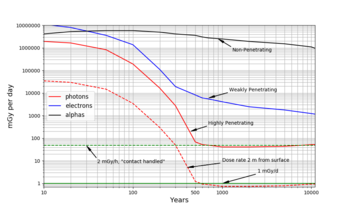User:David MacQuigg/Sandbox/Nuclear waste: Difference between revisions
No edit summary |
No edit summary |
||
| (5 intermediate revisions by the same user not shown) | |||
| Line 1: | Line 1: | ||
= A more realistic view of | = A more realistic view of spent fuel hazards = | ||
{{Image|Dose Rate at Fuel Element Surface.png|right|350px|Fig.3 Dose Rate at Fuel Element Surface.<ref>Graph is from Fig.4 in ''600 year old spent nuclear fuel is just another poison'', Jack Devanney, 13 Jan 2023 [https://jackdevanney.substack.com Substack.com]</ref>}} | {{Image|Dose Rate at Fuel Element Surface.png|right|350px|Fig.3 Dose Rate at Fuel Element Surface.<ref>Graph is from Fig.4 in ''600 year old spent nuclear fuel is just another poison'', Jack Devanney, 13 Jan 2023 [https://jackdevanney.substack.com Substack.com]</ref>}} | ||
Figure 1 in the [[Nuclear_waste_management]] article does not tell us much about the long term danger of spent nuclear fuel. | Figure 1 in the [[Nuclear_waste_management]] article does not tell us much about the long term danger of spent nuclear fuel. | ||
Long term radioactivity is mostly alpha particles and electrons (beta rays) harmlessly trapped | Long term radioactivity is mostly alpha particles and electrons (beta rays) harmlessly trapped inside the spent fuel. The more dangerous high-energy photons (gamma rays) can pass through the fuel element metal cladding, but they die out in a few hundred years. If we want to know how dangerous aging fuel rods are, we should look not at the total radioactivity inside the rod, but at the dose received by a person handling it. Alpha particles are stopped by a sheet of paper. Electrons are stopped by the outer layer of our skin. Both are stopped by the cladding. Instead of Becquerels per kilogram inside the rod, we need dose rates at the surface. See Figure 3.<br> | ||
Dose is the amount of radiation energy absorbed by our tissues, measured in joules | Dose is the amount of radiation energy absorbed by our tissues, measured in joules | ||
per kilogram of tissue. Gray is the scientific name for joules per kg. Figure 3 shows the dose rate in milligrays per day | per kilogram of tissue. Gray is the scientific name for joules per kg. Figure 3 shows the dose rate in milligrays per day | ||
(mGy/d). | (mGy/d) assuming no cladding. Alpha particles and electrons are stopped by the cladding. Only the photons are hazardous, but by year 600 | ||
almost all the photon emitters are gone. | almost all the photon emitters are gone. After year 600 the spent nuclear fuel must be swallowed in order to do any damage. | ||
After year 600 | |||
= The Staggering Timescales Of Nuclear Waste Disposal = | = The Staggering Timescales Of Nuclear Waste Disposal = | ||
Christine Ro, Forbes 2019 | Christine Ro, ''Forbes'' 2019 | ||
[https://www.forbes.com/sites/christinero/2019/11/26/the-staggering-timescales-of-nuclear-waste-disposal/?sh=273d53eb29cf] | [https://www.forbes.com/sites/christinero/2019/11/26/the-staggering-timescales-of-nuclear-waste-disposal/?sh=273d53eb29cf] | ||
"High-level nuclear waste consists largely of spent fuel from nuclear reactors. ... This most potent form of nuclear waste, according to some, needs to be safely stored for up to a million years. Yes, '''1 million years''' – in other words, a far longer stretch of time than the period since Neanderthals cropped up." | "High-level nuclear waste consists largely of spent fuel from nuclear reactors. ... This most potent form of nuclear waste, according to some, needs to be safely stored for up to a million years. Yes, '''1 million years''' – in other words, a far longer stretch of time than the period since Neanderthals cropped up." | ||
''Used Fuel Repository Conceptual Design and Postclosure Safety Assessment in Crystalline Rock'',Nuclear Waste Management Organization, | |||
NWMO TR-2012-16, 610 pages, December 2012. | |||
Latest revision as of 16:43, 19 January 2023
A more realistic view of spent fuel hazards

Figure 1 in the Nuclear_waste_management article does not tell us much about the long term danger of spent nuclear fuel.
Long term radioactivity is mostly alpha particles and electrons (beta rays) harmlessly trapped inside the spent fuel. The more dangerous high-energy photons (gamma rays) can pass through the fuel element metal cladding, but they die out in a few hundred years. If we want to know how dangerous aging fuel rods are, we should look not at the total radioactivity inside the rod, but at the dose received by a person handling it. Alpha particles are stopped by a sheet of paper. Electrons are stopped by the outer layer of our skin. Both are stopped by the cladding. Instead of Becquerels per kilogram inside the rod, we need dose rates at the surface. See Figure 3.
Dose is the amount of radiation energy absorbed by our tissues, measured in joules per kilogram of tissue. Gray is the scientific name for joules per kg. Figure 3 shows the dose rate in milligrays per day (mGy/d) assuming no cladding. Alpha particles and electrons are stopped by the cladding. Only the photons are hazardous, but by year 600 almost all the photon emitters are gone. After year 600 the spent nuclear fuel must be swallowed in order to do any damage.
The Staggering Timescales Of Nuclear Waste Disposal
Christine Ro, Forbes 2019 [1] "High-level nuclear waste consists largely of spent fuel from nuclear reactors. ... This most potent form of nuclear waste, according to some, needs to be safely stored for up to a million years. Yes, 1 million years – in other words, a far longer stretch of time than the period since Neanderthals cropped up."
Used Fuel Repository Conceptual Design and Postclosure Safety Assessment in Crystalline Rock,Nuclear Waste Management Organization, NWMO TR-2012-16, 610 pages, December 2012.
- ↑ Graph is from Fig.4 in 600 year old spent nuclear fuel is just another poison, Jack Devanney, 13 Jan 2023 Substack.com